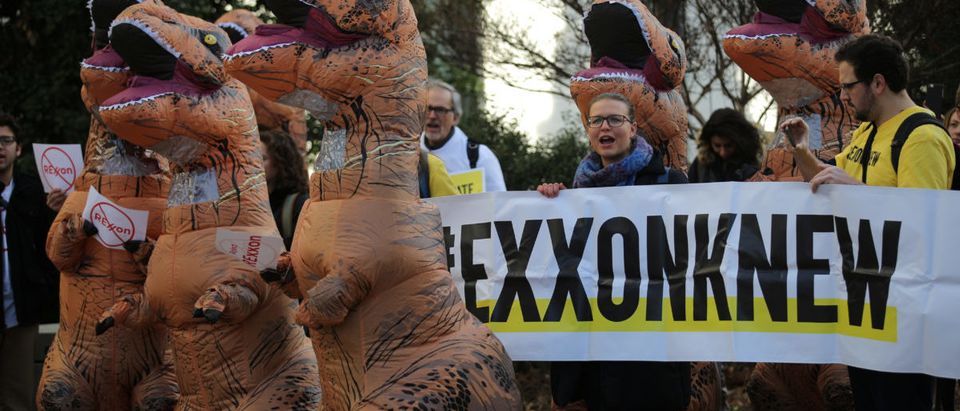Environmentalists seem to have failed to get a newly-formed iceberg named after oil giant ExxonMobil, who they blame for causing Antarctica’s Larsen C ice shelf to break up.
Instead, the Larsen C iceberg will likely be called A68.
Activists with 350.org petitioned the U.S. National Ice Center in June to name the Larsen C iceberg #Exxonknew, referring to claims the oil company tried to cover up the alleged dangers of global warming.
The petition is part of a broader effort by environmentalists to build public resentment towards Exxon. Activists say Exxon knew the risks of global warming as early as the 1970s but funded conservative groups skeptical of global warming to oppose federal regulations to curb fossil fuel use.
In essence, they want the iceberg to be a reminder of Exxon’s alleged sin against the planet.
“As one of the world’s largest icebergs is about to break off Antarctica, it should be named after Exxon: We need to make sure their role in causing the climate crisis is not forgotten,” the petition reads.
Even assuming Exxon really did try to cover up inconvenient climate science, there’s still no evidence Exxon played any role in breaking up the Larsen C ice shelf. Scientists said the breaking of the Larsen C ice shelf is likely due to natural forces, not man-made global warming.
“Although this is a natural event, and we’re not aware of any link to human-induced climate change, this puts the ice shelf in a very vulnerable position,” Martin O’Leary, a Swansea University glaciologist who has been tracking the Larsen C iceberg, said in a statement Wednesday.
350.org did not respond to The Daily Caller News Foundation’s request for comment.
Larsen C iceberg broke away from the greater ice shelf sometime between Monday and Wednesday. Scientists first noticed a crack in the ice shelf in 2014 and watched it rapidly expand over the last year.
350.org started its petition in June and claimed to have more than 10,000 signatures as of Monday.
“With one of the world’s biggest ice shelves at a breaking point, this destruction should bear the name of its greatest perpetrator: Exxon,” Aaron Packard, 350.org’s climate impact coordinator, said in a Monday statement touting their petition.
“People deserve to understand the devastation of Exxon’s decades of climate deception, and realize fossil fuel companies for the climate criminals they are,” Packard said in a press release blaming Exxon for the Larsen C iceberg.
The group initially petitioned the UK Antarctic Place Names Committee, but had to change their target to the National Ice Center after realizing the former group did not actually name icebergs.
350.org said the Larsen C ice shelf attached to the Antarctic Peninsula has warmed about three degrees Celsius since the mid-1960s. The group also said the iceberg’s break away “will set off feedback loops, including hastening ice collapse, sea level rise, and destabilization of the Antarctic region.”
Scientists said the Larsen C iceberg is unlikely to raise sea levels since the ice shelf already floats in the ocean. And recent data suggests the Antarctic Peninsula saw a cooling trend from 1999 to 2014.
Some media outlets and scientists, however, stressed the Larsen C breakup is a harbinger of things to come as the world continues to warm.
The New York Times, for example, noted ,”the breakup of ice shelves in the peninsula region may be a preview of what is in store for the main part of Antarctica as the world continues heating up as a result of human activity.”
Glaciologists tend to see this as a natural process of Antarctica. Ice shelves form, expand and then break apart when they stretch too far. Ice sheets are also impacted by annual variations in air and ocean temperatures.
“Glaciologists are not alarmed about most of these processes; they are examples of Antarctica simply doing what we know Antarctica has done for thousands of years,” professor Helen Amanda Fricker of the Scripps Institution of Oceanography wrote in late June.
Fricker wrote that “we do not need to press the panic button for Larsen C.”
“Large calving events such as this are normal processes of a healthy ice sheet, ones that have occurred for decades, centuries, millennia – on cycles that are much longer than a human or satellite lifetime,” she wrote.
Follow Michael on Facebook and Twitter
All content created by the Daily Caller News Foundation, an independent and nonpartisan newswire service, is available without charge to any legitimate news publisher that can provide a large audience. All republished articles must include our logo, our reporter’s byline and their DCNF affiliation. For any questions about our guidelines or partnering with us, please contact licensing@dailycallernewsfoundation.org.


